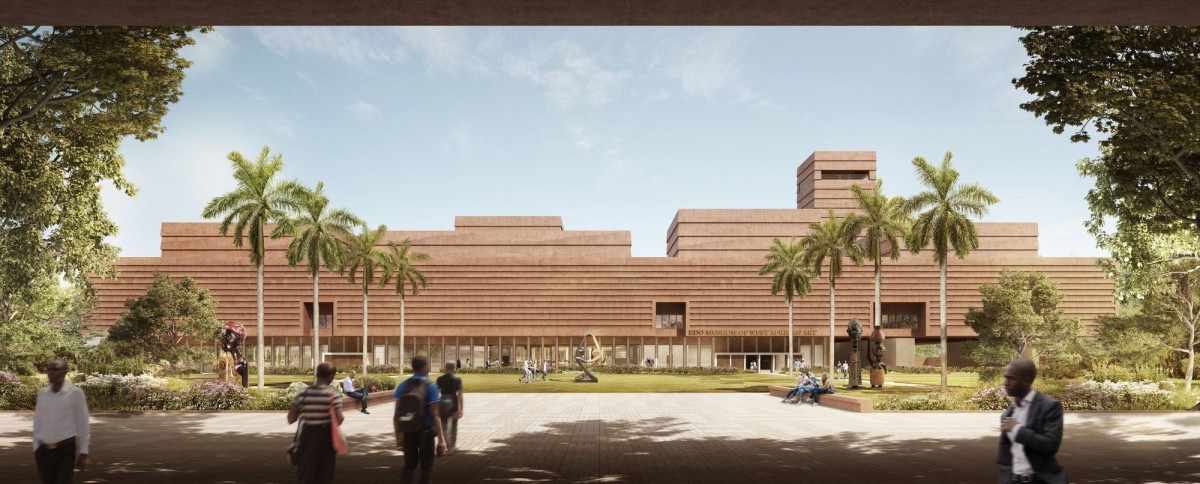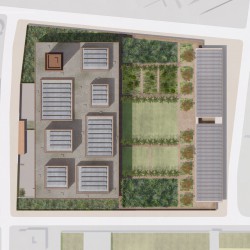Adjaye Associates have been appointed to undertake the initial concept and urban planning work on the new museum, and to assist in the assembly of a team of professionals in Nigeria.The architectural vision is to use archaeology as a means of connecting the new museum into the surrounding landscape, by revitalizing and incorporating the surviving remains of the walls, moats and gates of the historic city, seen throughout the modern city today. The museum project also recognizes the huge importance of the archaeological remains still preserved below the ground. The digging of the museum’s foundations will require careful excavations to prepare the site for the new museum building. The excavation of the site may reveal evidence of historic buildings which may be retained in their original position to become part of the visitor experience of the new museum.
EMOWAA Preliminary Design Concept
Adjacent to the Oba’s Palace, the new EMOWAA draws inspiration from its historical architectural typologies and establishes its own courtyard in the form of a public garden, exhibiting a variety of indigenous flora and a canopy that offers shade – a welcoming green environment suitable for gatherings, ceremonies and events. The galleries float above the gardens and are articulated by a series of elevated volumes – an inversion of the courtyard typology – within each of which sit pavilions which take their form from fragments of reconstructed historic compounds. These fragments allow the objects themselves to be arranged in their pre-colonial context and offer visitors the opportunity to better understand the true significance of these artefacts within the traditions, political economy and rituals enshrined within the culture of Benin City. A new dedicated space, EMOWAA will contain the rich, regal and sacred objects of Benin’s past, in a way that allows visitors not just the possibility of “looking in” but “looking out” into the visual landscape of imagining the once historic borders of a restored ancient kingdom.
The EMOWAA Archaeology Project
The archaeology project commences in 2021 and will continue for a period of five years to enable the timely construction of the museum. Initial work will involve extensive consultations with and input from local stakeholders – residents, historians, artists, and members of craft guilds – in a series of workshops, to help establish local priorities and interests. Initial archaeological work includes surveys of the museum site and the wider surroundings (LIDAR and geophysical surveys), to more fully understand the sub-surface remains and to help target excavations. The focus of excavations and fieldwork will be at the new museum site and in the immediate surroundings. Excavated objects will become part of the EMOWAA museum collections and displays, and all objects will remain in Nigeria. The project will be led by a joint Nigerian and British team and will involve the creation of a number of new roles. Archaeological heritage and research collaborations will be developed with a range of Nigerian and international partnerships, including a significant partnership with the National Commission for Museums and Monuments (NCMM). Educational partnerships with universities, technical institutes as well as schools and young learners, will further generate local involvement in the project and will seek to develop archaeological expertise through both practical experience and theoretical training.
The development of the project will run concurrently with the Digital Benin project, which will be collating all information and documentation on Benin material across the world on a single online platform.
Previous archaeological investigations in Benin City have focused largely on the monumental defensive wall structures which once surrounded the city and are today still partially visible. The limited test excavations, which took place in the centre of Benin City in the 1950s and 1960s, however, revealed some very important finds. These included preserved buildings and traces of elaborate pavements made of pottery fragments. Excavated objects comprised various metal-work items, such as a brass snake’s head and part of a plaque depicting a mudfish, as well as a variety of other objects telling the life of the pre-colonial kingdom, from decorated pottery vessels to traded glass beads. Today, these finds are little-known and the buildings and pavements lay buried below the modern city.
This project will look at new ways of engaging local communities, through workshops, publications, talks and digital content, reconnecting local people with their history and highlighting the significance of the history of the Kingdom of Benin.
_













